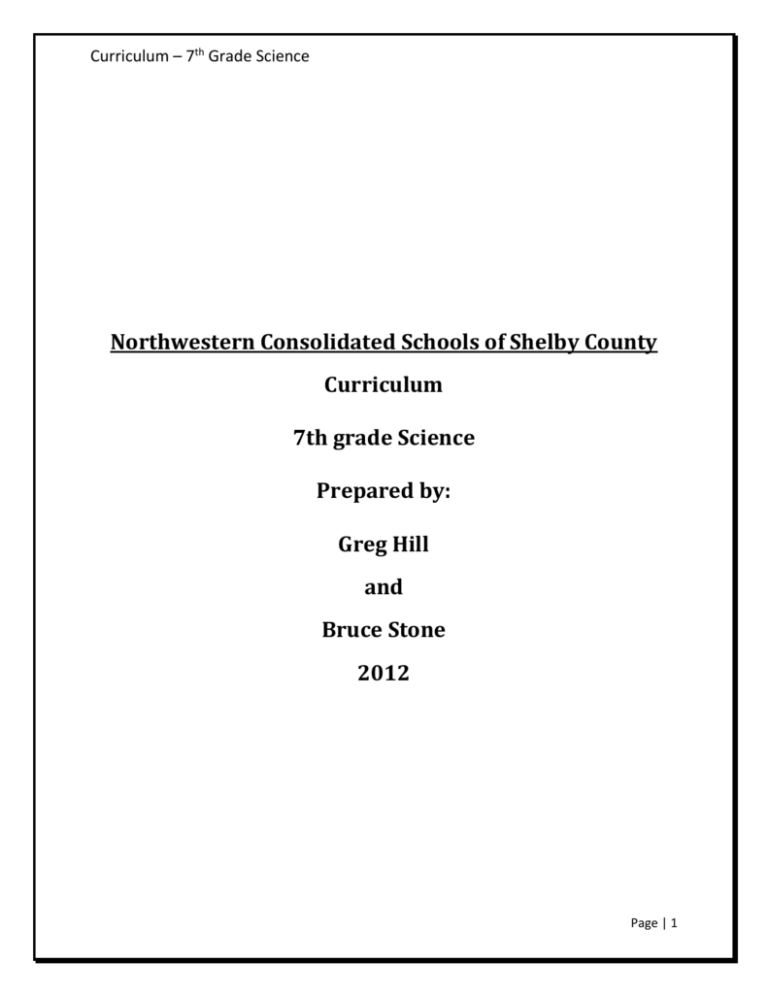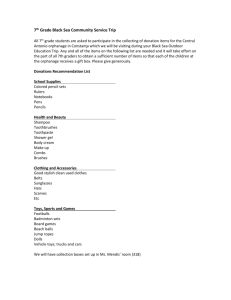Unit 1 – Nature of Science - Northwestern Consolidated Schools
advertisement

Curriculum – 7th Grade Science Northwestern Consolidated Schools of Shelby County Curriculum 7th grade Science Prepared by: Greg Hill and Bruce Stone 2012 Page | 1 Curriculum – 7th Grade Science Triton Central Middle School Mission Statement We are committed to providing and exiting, healthy, safe, and inspiring learning environment where staff, students, parents, and community think creatively and utilize teamwork to maximize learning and achievement. Page | 2 Curriculum – 7th Grade Science Triton Central Middle School 7th grade science Narrative Description Seventh grade science consists of a mix of earth science, physical science, and life science. Many of the concepts overlap and build on each other throughout the year allowing repetition to better enable students to retain the information. Page | 3 Curriculum – 7th Grade Science Course Concepts and Generalizations The Nature of Science and Technology Students gain scientific knowledge by observing the natural and constructed world, performing and evaluating investigations, and communicating their findings. These principles should guide student work and be integrated into the curriculum along with the content standards on a daily basis. Physical Science Explain that energy cannot be created or destroyed but instead can only be changed from one form into another or transferred from place to place. Describe and investigate how forces between objects can act at a distance or by means of direct contact between objects. Earth and Space Systems Describe how earth processes have shaped the topography of the earth and have made it possible to measure geological time. Life Science Understand the cellular structure of single-celled and multicellular organisms. The Design Process As citizens of the constructed world, students will participate in the design process. Students will learn to use materials and tools safely and employ the basic principles of the engineering design process in order to find solutions to problems. Science, Engineering and Technology Design and construct a device that converts energy from one form to another to perform work Page | 4 Curriculum – 7th Grade Science Unit 1 – Nature of Science (total days for Unit 1 = 20-25) Students gain scientific knowledge by observing the natural and constructed world, performing and evaluating investigations and communicating their findings. These principles should guide student work and be integrated into the curriculum along with the content standards on a daily basis. Indiana Academic Standards: Process Standards: 7.1 Make predictions and develop testable questions based on research and prior knowledge. (L2) 7.2 Plan and carry out investigations as a class, in small groups or independently often over a period of several class lessons. (L2) 7.3 Collect quantitative data with appropriate tools or technologies and use appropriate units to label numerical data. (L2) 7.4 Incorporate variables that can be changed, measured or controlled. (L2) 7.5 Use the principles of accuracy and precision when making measurement. (L3) 7.6 Test predictions with multiple trials. (L3) 7.7 Keep accurate records in a notebook during investigations. (L2) 7.8 Analyze data, using appropriate mathematical manipulation as required, and use it to identify patterns and make inferences based on these patterns. (L2) 7.9 Evaluate possible causes for differing results (valid data). (L3) 7.10 Compare the results of an experiment with the prediction. (L2) 7.11 Communicate findings using graphs, charts, maps and models through oral and written reports. (L2) Essential Questions What are the types of scientific knowledge? How are scientific investigations conducted? How do scientists organize, analyze, and present data? Page | 5 Curriculum – 7th Grade Science Lessons / Topics (total days) Lesson 1 – Scientific Knowledge (4) Lesson 2 – Scientific Investigations (4) Lesson 3 – Representing Data (3) Assessments Unit Pre-Post Exam Unit Project: Excel Basics, Bubble Gum data collecting and graphing with excel, M&M Graphing activity Vocabulary Quiz (1 per unit) Outline of Key Topics Lesson 1 – Scientific Knowledge The nature of science and empirical evidence Theory versus law Scientific change Lesson 2 – Scientific Investigations Types of scientific investigations Conducting a scientific investigation Characteristics of reliable scientific investigations Lesson 3 – Representing Data Tables Graphs Models Precision and Accuracy Key Vocabulary Empirical evidence, theory, law, experiment, observation, hypothesis, independent variable, dependent variable, data, model, precision, accuracy Page | 6 Curriculum – 7th Grade Science Unit 2 – Motion and Forces (total days for Unit 2 = 26) Explain that energy cannot be created or destroyed but only changed from one form into another or transferred from place to place. Indiana Academic Standards: Process Standards: 7.8 Analyze data, using appropriate mathematical manipulation as required, and use it to identify patterns and make inferences based on these patterns. 7.11 Communicate findings using graphs, charts, maps, and models through oral and written reports. Standard 1 - Physical Science: 7.1.5 Describe and investigate how forces between objects can act at a distance, such as magnetic, electrical, or gravitational forces, or by means of direct contact between objects. (L3) 7.1.6 Explain that forces have magnitude and direction and those forces can be added to determine the net force acting on an object. (L3) 7.1.7 Demonstrate and describe an object’s speed or direction of motion changes when a force acts upon it. Demonstrate and describe that an object’s speed and direction of motion remain unchanged if the net force acting upon it is zero. (L1,2,3) Essential Questions How are distance, time, and speed related? How does motion change? What causes motion? What are some types of forces? Lessons / Topics (total days) Lesson 1 – Motion and Speed (6) Lesson 2 – Acceleration (4) Lesson 3 – Forces (6) Lesson 4 – Types of Forces (5) Page | 7 Curriculum – 7th Grade Science Assessments Unit Pre-Post Exam Unit Project: to be determined Vocabulary Quiz (1 per Unit) Outline of Key Topics Lesson 1 – Motion and Speed Motion Speed Distance-Time graphs Velocity Lesson 2 – Acceleration Acceleration Acceleration as a vector Lesson 3 – Forces Introduction to force Balance and forces Laws of motion Lesson 4 – Types of Forces Contact forces Non-contact forces Effects of gravity Law of Universal Gravitation Key Vocabulary Position, reference point, motion, speed, vector, velocity, acceleration, centripetal acceleration, force, net force, inertia, contact force, non-contact force, magnetic force, electrical force, gravitational force Page | 8 Curriculum – 7th Grade Science Unit 3 – Energy (total days for Unit 3 = 34) Design Process – As citizens of the constructed world, students will participate in the design process. Students will learn to use materials and tools safely and employ the basic principles of the engineering design process in order to find solutions to a problem. Physical Science – Explain that energy cannot be created or destroyed but only changed from one form to another or transferred from place to place. Physical Science – Describe and investigate how forces between objects can act at a distance or by means of direct contact between objects. Science, Engineering, and Technology – Design and construct a device that converts energy from one form of Energy to another to perform work. Indiana Academic Standards: Design Process: 7.6 Create the solution through a prototype. (L4) 7.7 Test and evaluate how well the solution meets the goal. (L3) 7.8 Evaluate and test the design using measurement. (L5) Standard 1 – Physical Science: 7.1.1 Explain that when energy is transferred from one system to another, the total quantity of energy does not change. (L2) 7.1.2 Describe and give examples of how energy can be transferred from place to place and transformed from one form to another through radiation, convection, and conduction. (L3,6) 7.1.3 Recognize and explain how different ways of obtaining, transforming, and distributing energy have different environmental consequences. (L6) 7.1.4 Recognize and provide evidence how light, sound, and other waves have energy and how they interact with different materials. (L4,5) Standard 4 – Science, Engineering, and Technology: 7.4.1 Understand that energy is the capacity to do work. (L1) 7.4.2 Explain that energy can be used to do work using many processes, for example generation of electricity by harnessing wind energy. (L1,2,4) Page | 9 Curriculum – 7th Grade Science 7.4.3 Explain that power is the rate that energy is converted from one form to another. (L1) 7.4.4 Explain that power systems are used to provide propulsion for engineered products and systems. Essential Questions How is work related to energy? How is energy conserved? What is the relationship among heat, temperature, and thermal energy? What are waves? How do waves interact with matter? How do energy transformations affect the environment? Lessons / Topics (total days) Lesson 1 – Work, Energy, and Power (5) Lesson 2 – Conservation of Energy (5) Lesson 3 – Thermal Energy and Heat (4) Lesson 4 – Waves and Energy (5) Lesson 5 – Interactions of Waves and Matter (5) Lesson 6 – Effects of Energy Transfer (5) Assessments Unit Pre-Post Exam Unit Project: Energizing Indiana Kit Vocabulary Quiz (1 per Unit) Outline of Key Topics Lesson 1 – Work, Energy, and Power Work Energy Power Page | 10 Curriculum – 7th Grade Science Lesson 2 – Conservation of Energy Forms of energy Energy transformation Conservation of energy Energy efficiency Lesson 3 – Thermal Energy and Heat Thermal energy Heat Changes of state Methods of thermal energy transfer Lesson 4 – Waves and Energy What is a wave Mechanical waves Electromagnetic (EM) waves Wave properties Lesson 5 – Interactions of Waves and Matter Sound and matter Light and matter Color and illusion Lesson 6 – Effects of Energy Transfer Renewable and non-renewable resources Fossil fuels Alternative energy sources Key Vocabulary Work, energy, power, energy transformation, law of conservation of energy, efficiency, thermal energy, heat, calorie, conduction, conductor, insulator, convection, radiation, medium, longitudinal wave, transverse wave, mechanical wave, electromagnetic wave, amplitude, wavelength, wave period, frequency, wave speed, reflection, absorption, transmission, transparent, translucent, opaque, refraction, scattering, renewable resource, nonrenewable resource, fossil fuel Page | 11 Curriculum – 7th Grade Science Unit 4 – Earth’s Structures (total days for Unit 4 = 43) Describe how Earth processes have shaped the topography of the Earth, and have made it possible to measure geological time. Indiana Academic Standards: Process Standards: 7.8 Analyze data, using appropriate mathematical manipulation as required, and use it to identify patterns and make inferences based on these patterns. Standard 2 – Earth and Space Systems: 7.2.1 Describe how the Earth is a layered structure composed of lithospheric plates, a mantle, and a dense core. (L5,6) 7.2.2 Recognize that the Earth possesses a magnetic field that is detectable at the surface with a compass. (L2) 7.2.4 Explain how convection currents in the mantle cause lithospheric plates to move causing fast changes like earthquakes and volcanic eruptions, and slow changes like creation of mountains and formation of new ocean floor. (L6,7,8,9) 7.2.5 Describe the origin and physical properties of igneous, metamorphic, and sedimentary rocks and how they are related through the rock cycle. (L2,9) 7.2.6 Describe physical and chemical characteristics of soil layers and how they are influenced by the process of soil formation, including the action of bacteria, fungi, insects, and other organisms. (L4) 7.2.7 Use geological features such as karst topography and glaciation to explain how large-scale physical processes have shaped the land. (L3) Essential Questions What are minerals, how do they form, and how can they be used? What is the rock cycle? How do water and ice change the Earth’s surface? How does soil form? What are Earth’s layers? What is plate tectonics? How do mountains form? Page | 12 Curriculum – 7th Grade Science What are earthquakes? How do volcanoes change Earth’s surface? Lessons / Topics (total days) Lesson 1 – Minerals (4) Lesson 2 – The Rock Cycle (6) Lesson 3 – Processes that Shape the Land (4) Lesson 4 – Soil Formation (4) Lesson 5 – Earth’s Layers (3) Lesson 6 – Plate Tectonics (6) Lesson 7 – Mountain Building (3) Lesson 8 – Earthquakes (3) Lesson 9 – Volcanoes (5) Assessments Unit Pre-Post Exam Unit Project: Geology of a Changing Planet Vocabulary Quiz (1 per Unit) Outline of Key Topics Lesson 1 – Minerals Matter and minerals Formation of minerals Types of minerals Properties of minerals Page | 13 Curriculum – 7th Grade Science Lesson 2 – The Rock Cycle Rock and processes that change rock The classes and properties of rock Rock cycle Lesson 3 – Processes that Shape the Land Erosion and deposition by surface water Erosion and deposition by ground water Erosion and deposition by ice Lesson 4 – Soil Formation Soil formation Soil horizons Soil characteristics Lesson 5 – Earth’s Layers Earth’s compositional layers Earth’s physical layers Lesson 6 – Plate Tectonics Theory of plate tectonics Tectonic plates Types of plate boundaries Causes of tectonic plate motion Lesson 7 – Mountain Building Deformation and folding Faulting Mountains Lesson 8 – Earthquakes What earthquakes are and why they happen Where earthquakes happen Effects of earthquakes Page | 14 Curriculum – 7th Grade Science Lesson 9 – Volcanoes Volcanoes Volcanic landforms Where volcanoes form Key Vocabulary Mineral, element, atom, compound, matter, crystal, streak, luster, cleavage, weathering, erosion, deposition, igneous rock, sedimentary rock, metamorphic rock, rock cycle, uplift, subsidence, rift zone, floodplain, delta, alluvial fan, groundwater, sinkhole, karst topography, glacier, glacial drift, crust, mantle, convection, core, lithosphere, asthenosphere, mesosphere, Pangaea, convergent boundaries, divergent boundaries, transform boundaries, tectonic plates, plate tectonics, deformation, folding, fault, shear stress, tension, compression, earthquake, focus, epicenter, elastic rebound, volcano, magma, lava, vent, hot spot Page | 15 Curriculum – 7th Grade Science Unit 5 – The Changing Earth (total days for Unit 5 = 17) Describe how Earth processes have shaped the topography of the earth and have made it possible to measure geological time. Indiana Academic Standards: Process Standards: 7.8 Analyze data, using appropriate mathematical manipulation as required, and use it to identify patterns and make inferences based on these patterns. 7.9 Evaluate possible causes for differing results (valid data). Standard 2 – Earth and Space Systems: 7.2.3 Characterize the immensity of geologic time and recognize that it is measured in eras and epochs. (L3) 7.2.8 Compare and contrast fossils with living organisms in a given location to explain how Earth processes have changed environments over time. (L1,2,3) Essential Questions What do fossils tell us about Earth’s history? How do scientists measure the ages of rock? How do we learn about Earth’s history? Lessons / Topics (total days) Lesson 1 – Fossils and Changing Environments (4) Lesson 2 – Relative Dating and Absolute Dating (4) Lesson 3 – Geologic Change over Time (4) Assessments Unit Pre-Post Exam Unit Project: to be determined Vocabulary Quiz (1 per Unit) Page | 16 Curriculum – 7th Grade Science Outline of Key Topics Lesson 1 – Fossils and Changing Environments Fossils Fossils as evidence of Earth’s changing environments and climates Lesson 2 – Relative Dating and Absolute Dating Rock layers in relative dating Fossils and geological columns in relative dating Absolute dating Index fossils Lesson 3 – Geologic Change over Time Records of Earth’s geological history Earth’s changing landforms Evidence for changes in Earth’s climate The geological time scale Key Vocabulary Fossil, trace fossil, relative dating, law of superposition, unconformity, geologic column, absolute dating, radioactive decay, half-life, radiometric dating, continental drift, climate, ice core, geologic time scale, eon, era, period, epoch Page | 17 Curriculum – 7th Grade Science Unit 6 – The Cell (total days for Unit 6 = 28) Understand the cellular structure of living organisms, both single-celled and multicellular. Indiana Academic Standards: Process Standards: 7.1 Make predictions and develop testable questions based on research and prior knowledge. 7.10 Compare the results of an experiment with the prediction. Standard 3 – Life Science: 7.3.1 Explain that all living organisms are composed of one or more cells and that the many functions needed to sustain life are carried out within such cells. (L1,2) 7.3.2 Understand that water is a major component within cells and is required to carry out many cellular functions. (L2) 7.3.3 Explain that although the way cells function is similar in all living organisms, multicellular organisms also have specialized cells, whose specialized functions are directly related to their structure. (L3) 7.3.4 Compare and contrast similarities and differences between specialized subcellular components within plant and animal cells, including organelles and cell walls that perform essential functions and give a cell its shape and structure. (L3) 7.3.5 Explain that cells in multicellular organisms repeatedly divide to make more cells for growth and repair. (L4) 7.3.6 Explain that after fertilization, a small cluster of cells divides to form the basic tissues of an embryo which further develops into all the specialized tissues and organs within a multicellular organism. (L5) 7.3.7 Describe how various organs and tissues serve the needs of cells for nutrient and oxygen delivery and waste removal. (L4,5) Page | 18 Curriculum – 7th Grade Science Essential Questions What are living things made of? What are the building blocks of organisms? What are the different parts that make up a cell? How do organisms maintain homeostasis? How are living things organized? Lessons / Topics (total days) Lesson 1 – The Characteristics of Cells (4) Lesson 2 – Chemistry of Life (4) Lesson 3 – Cell Structure and Function (5) Lesson 4 – Homeostasis and Cell Processes (6) Lesson 5 – Levels of Cellular Organization (4) Assessments Unit Pre-Post Exam Unit Project(s): Create plant or animal 3D cell model Vocabulary Quiz (1 per unit) Outline of Key Topics Lesson 1 – The Characteristics of Cells The cell The cell theory Two types of cells Lesson 2 – Chemistry of Life Atoms and molecules Four main molecules Cell membranes Page | 19 Curriculum – 7th Grade Science Lesson 3 – Cell Structure and Function Eukaryotic cells Parts of Eukaryotic cells Plant and animal cells Lesson 4 – Homeostasis and Cell Processes Homeostasis Cell energy and cell cycle Material exchange in cells Lesson 5 – Levels of Cellular Organization Cells to organisms Cellular structure and function Systems work together Key Vocabulary Cell, organism, cell membrane, cytoplasm, organelle, nucleus, prokaryote, eukaryote, atom, molecule, lipid, protein, carbohydrate, nucleic acid, phospholipid, cytoskeleton, mitochondrion, ribosome, endoplasmic reticulum, Golgi complex, cell wall, vacuole, chloroplast, lysosome, homeostasis, photosynthesis, cellular respiration, mitosis, passive transport, diffusion, osmosis, active transport, endocytosis, exocytosis, organism, tissue, organ, organ system, structure, function Page | 20







